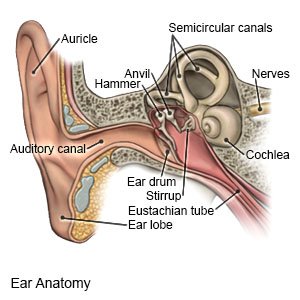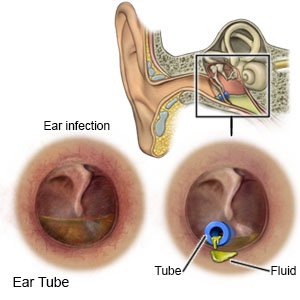Eustachian Tube Dysfunction
Medically reviewed by Drugs.com. Last updated on Aug 4, 2025.
AMBULATORY CARE:
Eustachian tube dysfunction (ETD)
is a condition that prevents your eustachian tubes from opening properly. It can also cause them to become blocked. Eustachian tubes connect your middle ear to the back of your nose and throat. These tubes open and allow air to flow in and out when you sneeze, swallow, or yawn.
 |
Common signs and symptoms include the following:
- Fullness or pressure in your ears
- Muffled hearing, or a feeling you are hearing under water or have clogged ears
- Pain in one or both ears
- Ringing in your ears
- Popping, crackling, or clicking feeling in your ears
- Trouble keeping your balance
Call your doctor or otolaryngologist if:
- Your symptoms do not improve or get worse.
- You have a fever.
- You have any hearing loss.
- You have questions or concerns about your condition or care.
Treatment:
ETD may get better on its own without any treatment. If it continues, you may need any of the following:
- Swallow, yawn, or chew gum to help open your eustachian tubes. Your healthcare provider may also recommend you blow with your mouth shut and your nostrils pinched closed.
- Air pressure devices push air into your nose and eustachian tubes to help relieve air pressure in your ear.
- Treatment for allergies such as decongestants, antihistamines, and nasal steroids may improve ETD. They may help decrease swelling of the eustachian tubes.
- A myringotomy is surgery to make a hole in your eardrum. The hole relieves pressure and lets fluid drain from your ear. A pressure equalizing (PE) tube may be used to keep the hole open and to help drain fluid.

- Tuboplasty is a procedure to widen your eustachian tubes.
Treatment options
The following list of medications are related to or used in the treatment of this condition.
Follow up with your doctor or otolaryngologist as directed:
Write down your questions so you remember to ask them during your visits.
© Copyright Merative 2025 Information is for End User's use only and may not be sold, redistributed or otherwise used for commercial purposes.
The above information is an educational aid only. It is not intended as medical advice for individual conditions or treatments. Talk to your doctor, nurse or pharmacist before following any medical regimen to see if it is safe and effective for you.
Learn more about Eustachian Tube Dysfunction
Treatment options
Care guides
Medicine.com guides (external)
Further information
Always consult your healthcare provider to ensure the information displayed on this page applies to your personal circumstances.
